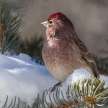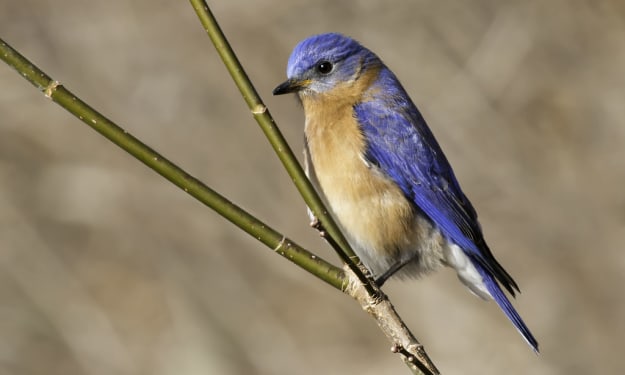
The corn bunting (Emberiza calandra) is a passerine bird in the family Emberizidae, a group that most western authors, Fringillidae, now separate from the finches. It is generally placed in the genus Emberiza but some taxonomists place it in the monotypical genus Miliaria. The genus Emberiza's name is a bunting, from Old German Embritz. The famous calandra is the calandra lark, a kalandros from ancient Greek. Maize bunting is a sparrow-sized, streaky brown hedgerow and farm land bird that feeds on seeds and invertebrates. In the winter it will join mixed flocks of buntings, finches, and sparrows to feast on seasonal crops. Male corn buntings are frequently seen sitting on top of gently singing branches, a song that sounds like a set of keys jangling about. Male corn buntings will accommodate as many as 18 different females in one season. The female builds her grass nest in rough grassy margins or arable crops, and incubates the eggs herself. After they have hatched, the male will help feed the chicks. This is a unusual bunting because the sex plumages look the same, but the male is around 20 per cent bigger than the female. This large thick bunting is 16–19 cm long, with a conspicuously black eye and yellowish mandibles. Males lack any showy colours, particularly on the eyes, otherwise characteristic of the genus Emberiza. Both sexes look like larks, whitish underparts above streaked grey-brown. The underpieces are stretched over the flanks and breast, and the extending forms gorget across arms. The wing's smaller covers are notably dark and white-tipped. The hair is very brunette. The song of the male is a repetitive metallic sound, usually associated with low brush, fence post or telephone wires jangling keys. It breeds into Kazakhstan in Southern and Central Europe, North Africa and Asia. This is largely resident, but some cooler Central European and Asian birds migrate to the south in winter. The bunting of corn is an open field crop of plants, between forest and weedy desert. It has declined significantly in North-West Europe due to intensive agricultural practises that strip it of its food sources of weed seeds and insects, the latter being especially important for feeding the young. This has recently become extinct in Wales and Ireland, where it had once been common. Its natural diet is primarily seeds but also includes insects such as crickets, particularly when feeding young people. Males defend territories during the breeding season, which may be polygynous, with up to three females per male mating. Population-to-sex ratio is typically 1:1, which means that males stay unmated throughout a season. Males have only a small portion of parental care; they are not involved of breeding or incubation, and only feed the chicks until they have grown more than half. The nest is built from grass, lined with hair or fine grass, and is generally constructed on the ground. The average size of the clutch is 4 but usually varies from 3 to 5, often 6. In England, Natural England, the government's protection department offers funds to take measures to protect this area under the environmental stewardship programme. Corn bunting is big, bright, streaky, brown bunting. It's very similar to the Skylark, but with a thicker neck, and no crest. It's smaller than most buntings so it can be difficult to tell apart this group. Corn bunting isn't a migratory bird in the UK; in fact it's so sedentary that males just 30 km away sing with different ' dialects. ' Slightly bigger than Reed Bunting, with longer, conical wings. Like the other three bunting species that breed in Ireland, male and female Corn Buntings have no distinct plumages. Similar to juvenile Yellowhammer, with some broken black stripes on light grey edges. The subparts are off white, with the black edges indistinct. Most birds have a low, dark spot on the breast. Corn Buntings mainly has a pink bill as opposed to Yellowhammer.
About the Creator
MB
I am a bird aficionado and really enjoy spotting them them on hikes. I greatly appreciate the variety of birds cross North America and the world. They are amazing and intelligent creatures, each so unique and with a wonderful life.






Comments
There are no comments for this story
Be the first to respond and start the conversation.